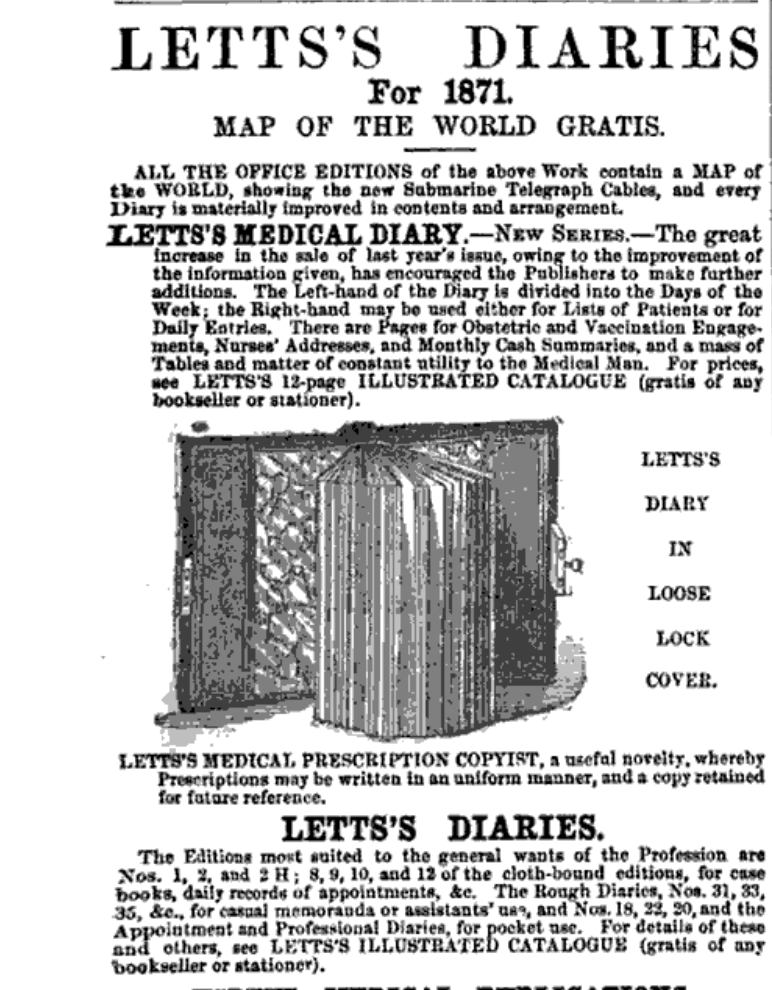Pre-Printed Diaries and Almanacs: An Aid to Managing the Diseases of Modern Life?
Hannah Wills, our new Research Assistant, introduces her work on Victorian diaries.
In the Victorian period, individuals complained of the quickening pace of life, of a greater ‘velocity in thought and action’ than had ever been experienced before.[1] I’m interested in exploring the practical tools that were available to manage this phenomenon, in terms of personal information management on paper. One available solution was the pre-printed diary or planner, marketed as a useful receptacle for everything from financial transactions to social engagements, from the day’s weather to daily food intake. An advert in the Spectator for 23 December 1848 described two such commercial publications, Letts’s Diary, or Bills-Due Book, and Letts’s Indispensable Almanack, both produced by the highly successful Letts stationary company, founded in 1796 by John Letts. As the advert for Letts’s almanac promised, such products were invaluable in ‘enabling Everybody to secure to himself a faithful Record of the Past, the Present, and the Future’.
The origins of British pre-printed diaries can be traced back to mid-eighteenth-century almanacs and pocket diaries of a similar nature. These diaries and almanacs had a range of contents, including selections of useful reference information, usually at the front, including weights and measures, conversion charts and notable public holidays, alongside entertaining anecdotes, brain-teasing puzzles and dated blank spaces for the writing of diary entries. The nineteenth century saw an explosion in the number of printed diaries available for purchase, containing much of the same content.[2] One edition of Letts’s diary, published for the year 1874, began with a reference section that included the dates of the law and university terms, a list of the names and ages of the sovereigns of Europe and a table for calculating the interest on sums of money at different percentages. The rest of the diary was arranged with blank spaces for the insertion of dated diary entries, with two days set out per page.[3]

(Advert for Letts’s diaries from The Lancet, 7 Jan. 1871, Advertiser. Image credit: Google Books)
Pre-printed diaries and almanacs were marketed at a variety of individuals and professions in the nineteenth century. In a catalogue of their works for the year 1856, Letts, Son & Co. described a range of published editions of their popular diary. These included pocket versions, described as being of use to ‘Physicians’ and ‘Tourists’, as well as cheaper editions, more suited to ‘Mechanics, Warehousemen, &c’. Alongside those suited to particular professions, versions were also advertised ‘For Private Use, of Noblemen, Gentlemen, and Ladies’. Each edition was numbered, with different editions containing different reference information and a different arrangement of days printed on each page. A ‘new form for the pocket’, produced by Letts and marketed specifically at physicians, contained sections for recording daily appointments, births and vaccinations.

(The arrangement of the diary pages varied in different editions of the diary, as advertised in Letts’s catalogue. A Catalogue of Other Works, Published, Sold, or Manufactured by Letts, Son & Co. 1855. Image credit: Google Books)
Letts’s advertising positioned its products as practical aids for the management of time, as one solution to the problem of an increase in the pace of modern life. Musing on the general benefits of keeping a diary, Letts’s catalogue suggested to all diarists that ‘Before you lie down to sleep, or before you leave your dressing room in the morning... Read over the Entries of the Past Day to provide against any omission, and then those of to morrow (if there be any) to arrange your time in the most advantageous manner’.
Within the diaries themselves, one finds allusions to other modern ailments, including worry and mental strain. In addition to the reference sections at the beginning, and the middle pages used for recording daily activities, some diaries and planners contained adverts for other products. Letts’s number 42 diary for the year 1874 featured several full pages of adverts, some for items associated with stationary and the act of writing, including ‘Letts’s Patent Perpetual Inkstand’, Joseph Gillott’s ‘celebrated Steel Pens’, and a range of leather portmanteaus, expanding bags and cases, sold by John Pound & Co. Several medical adverts were also featured, including one for ‘Lamplough’s Pyretic Saline’, a patent medicine that promised to cure ‘Nervous Headache in a few minutes’. Just below was an advert for F. Walters & Co., ‘Manufacturers of Abdominal Supports For Ladies before and after Confinement’, and a range of ‘Artificial Legs, Arms, and Eyes’.
In the nineteenth century, patent medicines were often advertised in planners and almanacs. Many patent medicine companies designed and produced their own yearly planners, distributed for free, that featured adverts for their products alongside a reference calendar for the year.[4] It is possible that commercial stationers and patent medicine companies saw a connection between the desire to record one’s daily activities and engagements, and the desire to manage one’s health. It is striking that printed diaries and almanacs, tools for managing the pace of Victorian life, were also used to advertise medical products, some of which were aimed at combatting the diseases of modern life.
[1] James Crichton Browne, ‘The History and Progress of Psychological Medicine: An Inaugural Address’. Royal Medicine Society, Edinburgh, 1860. p. 9.
[2] Rebecca Steinitz, "Social Spaces for the Self: Organising Experience in the Nineteenth-Century British Printed Diary." a/b: Auto/Biography Studies 16, no. 2 (2001): 161-74. Hazel Tubman, "The First Pre-Printed Diaries: Origins, Development and Uses of an Information Genre, 1700-1850." PhD thesis, University of Oxford, 2016.
[3] Letts's Diary or Bills Due Book, and an Almanack for 1874. London: Letts, Son & Co., 1873.
[4] Louise Hill Curth, "Medical Advertising in the Popular Press: Almanacs and the Growth of Proprietary Medicines." Pharmacy in History 50, no. 1 (2008): 3-16.



